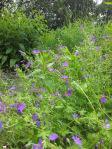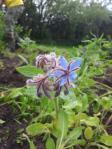We are going to create a bee friendly growing bed in the Eco Garden. The bed will be in flower from as early in the year to as late as possible. The idea is that multiple flowers will have nectar available at anyone time.
On a practical note, the bed that is being replaced is 5 – 6 years old with not much reminisce of its previous glory. This bed will look at its longer term life and aim to hit full maturity in 5 years. This will mean less maintenance and healthier plants.
The Plants
Lemon Balm
This is one of my favorite plants in the park, as it grows to well and has so many uses. It is extremely be friendly, to the point of its Latin name Melissa officinalis being derived from the Greek for honey bee.
It grows to up to 1m and produces flowers throughout the summer.
Rosemary
This will form the center of the bed, a 1.5m woody shrub that will mature after 5 years. It produces flowers early in spring to give the bee’s some nectar at the beginning of the year.
Potentilla
Another prominant shrub will be the Potentilla from the Rose family. It too takes 5 years to mature into a 1m height plant. It produces flowers in spring and through to summer.
Burdock
Another tall perennial that will grow up to 1.5.m tall. It flowers late summer into Autumn.

Feverfew
This is a smaller 0.5m tall bushy plant that will mature in a couple of years, offering flowers throughout the summer months.

Geranium
These are similar to Feverfew. They will give flowers through summer and mature in a couple of years. The plant will form a larger clump of around 1m.
Borage
This annual easily self seeds and will cultivate the space in the early life of the bed but will eventually be overtaken by the larger perennials. They will flower throughout summer and grow up to 1m tall.

Strawberry
As with all fruit, first comes the flowers, which come in spring to again offer some nectar early in the year.
Dahlia
These are grown from tubers and require to be taken out and overwintered but are worth the extra effort. The single flowered plants are excellent nectar plants for late summer into autumn and are a treat for our eyes. The large tubers can grow to 1.5m tall and spread over 1m.
Thanks to the rhs plant index for the information

Autumn
Lemon Balm – can be planted by root division
Rosemary – Take a softwood cutting in early autumn, or a hardward cutting in late autumn/ early winter
Potentilla – Plant out
Burdock – Collect seeds
Feverfew – Can be planted by root division
Borage – Collect seed
Strawberry – pot up runners
Winter
Dahlia – overwinter tubers
Spring
Burdock – Plant seeds
Borgae – Plant seeds
Geranium – can be divided in spring
Strawberry – Transplant
Dahlia – Plant out tubers
